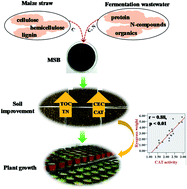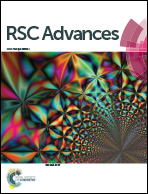Biochar prepared from maize straw and molasses fermentation wastewater: application for soil improvement†
Abstract
A novel method was applied to improve biochar properties and its soil application by introducing molasses fermentation wastewater into a maize straw pyrolysis process. In this study, maize straw biochar (MSB) was prepared from maize straw mixed with different amounts (1, 2 and 3 mL g−1 straw, v/w) of molasses fermentation wastewater which contained high organics and nitrogen contents. Characterization results indicated that the yield, carbon content, N/C, and cation exchange capacity (CEC) of MSB increased gradually with the increasing dosage of fermentation wastewater. In addition, the prepared MSB was added into sandy soil with four mixing proportions (1%, 3%, 5% and 10%, w/w) to investigate its effects on plant growth, soil properties and soil catalase activity (CAT) by pot experiments. The results indicated that MSB amendments increased soil pH, soil total organic carbon (TOC) and nutrients contents (TN, TP). It was suggested that 5% biochar proportion in soil derived from maize straw with 2 mL g−1 fermentation wastewater addition was more suitable for ryegrass growth, soil fertility and CAT activity improvement. This study provides a promising way to realize the resource utilization of fermentation wastewater and agricultural wastes at the same time.



 Please wait while we load your content...
Please wait while we load your content...